Key Takeaways
- FDA label terms are standardized phrases that appear on every approved drug label.
- Contraindication tells you when a drug must NOT be used, while Precautions warn about risks that need careful management.
- Description provides the chemical identity and structure of the active ingredient.
- Dosage and Administration gives step‑by‑step dosing instructions for all patient groups.
- Understanding each term helps clinicians read labels faster and improves patient safety.
The FDA’s labeling system can feel like a foreign language, especially when you’re scanning a new prescription. Every label follows a strict template, and each section has a precise legal meaning. This glossary breaks down the most common terms-from Contraindication to the section that warns about serious risks and how to mitigate them-so you know exactly what to look for and why it matters.
What Is an FDA Label Term?
In FDA parlance, a FDA label term is a defined phrase that appears in the prescribed order of a drug’s official label. The label is a legally binding document governed by 21 CFR 314.70 for human drugs and 21 CFR 601.12 for biologics. Each term signals a specific type of information that must be presented in a clear, concise format. The standardization makes it possible for doctors, pharmacists, and patients to find critical safety data quickly, no matter which medication they’re reviewing.
Contraindication
Contraindication is defined by the FDA as "specific situations when the drug should not be used because it may be harmful to the patient." It appears right after the Indications and Usage section and before Warnings and Precautions. There are two flavors:
- Absolute contraindication: use is never recommended (e.g., active pathological bleeding for Xarelto).
- Relative contraindication: use may be considered if benefits outweigh risks (e.g., severe renal impairment for certain NSAIDs).
Regulation 21 CFR 201.57(c)(2) mandates that contraindications be brief, meaningful, and free of trivial risks. The Highlights section of the label must include the most critical contraindications for instant physician visibility.
Description
Description refers to the part of the label that spells out the chemical identity of the active ingredient. This includes the established name, the precise chemical name, and, when applicable, a structural formula that shows stereochemistry. 21 CFR 201.56(b)(2) requires a short summary of the drug substance, so you’ll see entries like "recombinant human IgG1 monoclonal antibody" for Humira (adalimumab) along with its molecular weight and amino‑acid sequence. The section appears both in the Highlights and the Full Label, ensuring that scientists and clinicians alike have access to the exact composition.
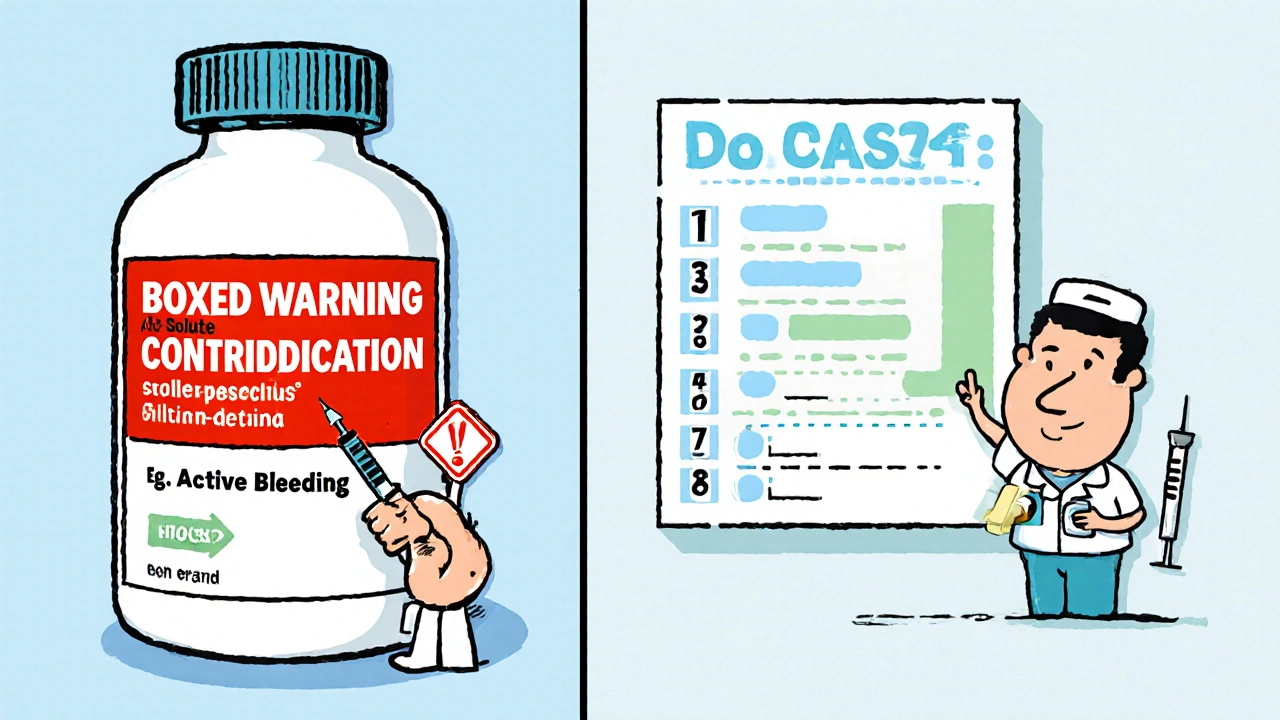
Dosage and Administration
Dosage and Administration is the section that tells you how much drug to give, how often, and by which route. It also includes special‑population adjustments for pediatrics, geriatrics, hepatic or renal impairment, and pregnancy. The FDA’s 21 CFR 201.57(d) and 21 CFR 201.56(b)(5) require the information to be presented in a step‑by‑step format that is easy to follow during a time‑pressured clinical encounter.
For example, the Keytruda (pembrolizumab) label lists two dosing regimens: 200 mg every three weeks or 400 mg every six weeks, plus detailed instructions on how to reduce the dose if severe immune‑related adverse events occur. Such clarity helps avoid dosing errors, which accounted for 14.7% of post‑approval label changes in 2023.
Drug Interactions
Drug Interactions are situations where one drug changes the activity of another, a supplement, food, or beverage. The FDA requires clinically significant interactions to be listed under 21 CFR 201.57(f). Studies must evaluate major metabolic pathways-especially CYP enzymes and transporters like P‑gp.
Take apixaban (Eliquis) as an example: its label warns against co‑administration with strong dual inhibitors of CYP3A4 and P‑gp (e.g., ketoconazole) because exposure can rise dramatically, increasing bleeding risk. The guidance released in February 2020 set the standard for how these studies are designed and reported.
Indications and Usage
Indications and Usage is the opening section that defines the disease or condition a drug is approved to treat, along with the patient population. Under 21 CFR 201.56(b)(1), the language must be specific about the disease, the target group, and the treatment goal.
Opdivo (nivolumab) illustrates this well: the label states "treatment of patients with unresectable or metastatic melanoma as a single agent or in combination with ipilimumab." Such precision is required to support the substantial‑evidence standard of 21 CFR 314.126, which demands well‑controlled clinical trials.
Patient Counseling Information
Patient Counseling Information provides clear, actionable advice that clinicians should pass on to patients. It must cover how to take the medication, what side effects to watch for, and storage instructions, per 21 CFR 208.20‑208.26.
The Jardiance (empagliflozin) label, for instance, tells patients to report genital yeast infections, increased thirst, or signs of ketoacidosis immediately. The FDA’s 2021 guidance stresses plain language-no jargon-so patients understand the risk and act quickly.
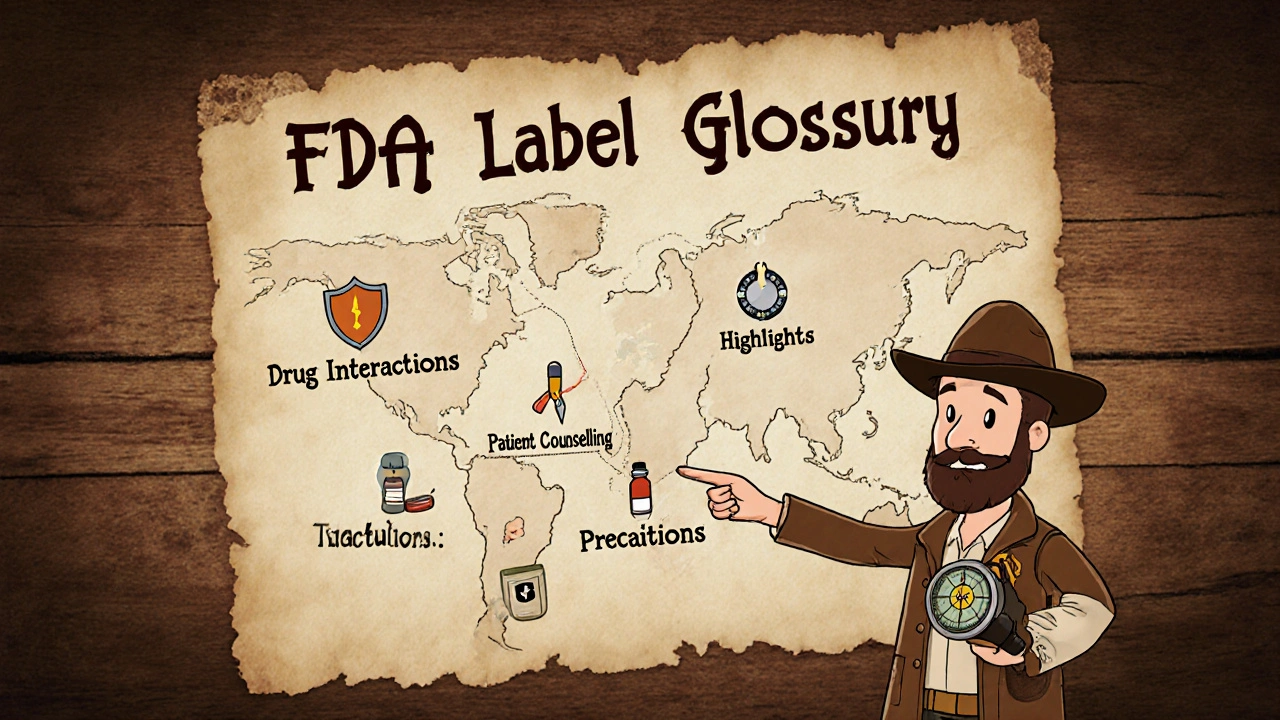
Precautions (Warnings & Precautions)
Precautions combine the Warnings and Precautions section, highlighting serious adverse reactions and steps to mitigate them. 21 CFR 201.57(c) orders that the most severe risks appear first and are separated clearly from less critical information.
A Boxed Warning-a red‑bordered highlight-appears when there is reasonable evidence of a life‑threatening risk. Trulicity (dulaglutide) carries a boxed warning about thyroid C‑cell tumors, explicitly instructing providers not to use it in patients with a personal or family history of medullary thyroid carcinoma. According to the 2023 CDER report, about 31.7% of novel drug approvals between 2020‑2023 included at least one Boxed Warning.
Regulatory Foundations: 21 CFR 314.70 and Drugs@FDA
All the sections above are anchored in 21 CFR 314.70, the part of the Code of Federal Regulations that spells out the content and format requirements for human drug labeling. The FDA’s Drugs@FDA database hosts the official label for every approved product. Since 2007, labels are submitted in Structured Product Labeling (SPL) XML, enabling searchable, machine‑readable data that feeds clinical decision‑support tools. The 2024 draft guidance on “Enhancing the Utility of Drug Labeling Through Digital Innovation” promises interactive elements in electronic labels by mid‑2025.
Practical Tips for Using the Glossary
- Scan the Highlights first. The top “Highlights” box contains Contraindications, Boxed Warnings, and key Dosage information-perfect for a quick safety check.
- Jump to the section you need. Use the standardized headings (e.g., “Drug Interactions”) to navigate the SPL‑formatted label on Drugs@FDA.
- Cross‑check Patient Counseling. Make sure the advice you give aligns with the label’s counseling section; it’s the most patient‑friendly part of the document.
- Stay updated. Post‑marketing changes (Category 2 updates) happen often; subscribe to the FDA’s label change alerts to keep your knowledge current.
Conclusion
Knowing what each FDA label term means cuts through the jargon and lets you focus on the real clinical takeaways. Whether you’re a prescriber, pharmacist, or a patient looking up a medication, this glossary gives you a reliable map to the most important safety and usage information.
What is the difference between a contraindication and a precaution?
A contraindication tells you when a drug must not be used at all, while a precaution highlights serious risks that require special attention but don’t outright forbid use.
Where can I find the official FDA label for a medication?
The FDA’s Drugs@FDA website hosts the complete, searchable label for every approved drug in SPL format.
How often are label sections updated?
Label updates occur whenever new safety or efficacy data emerge; about 97% of changes from 2015‑2020 were Category 2 updates processed under 21 CFR 314.70(c).
What should I look for in the Dosage and Administration section?
Check the recommended dose, route, frequency, and any adjustments for age, weight, organ impairment, or concomitant medications.
Why are Boxed Warnings so prominent?
Boxed Warnings flag life‑threatening or irreversible risks, requiring immediate attention from prescribers and patients.
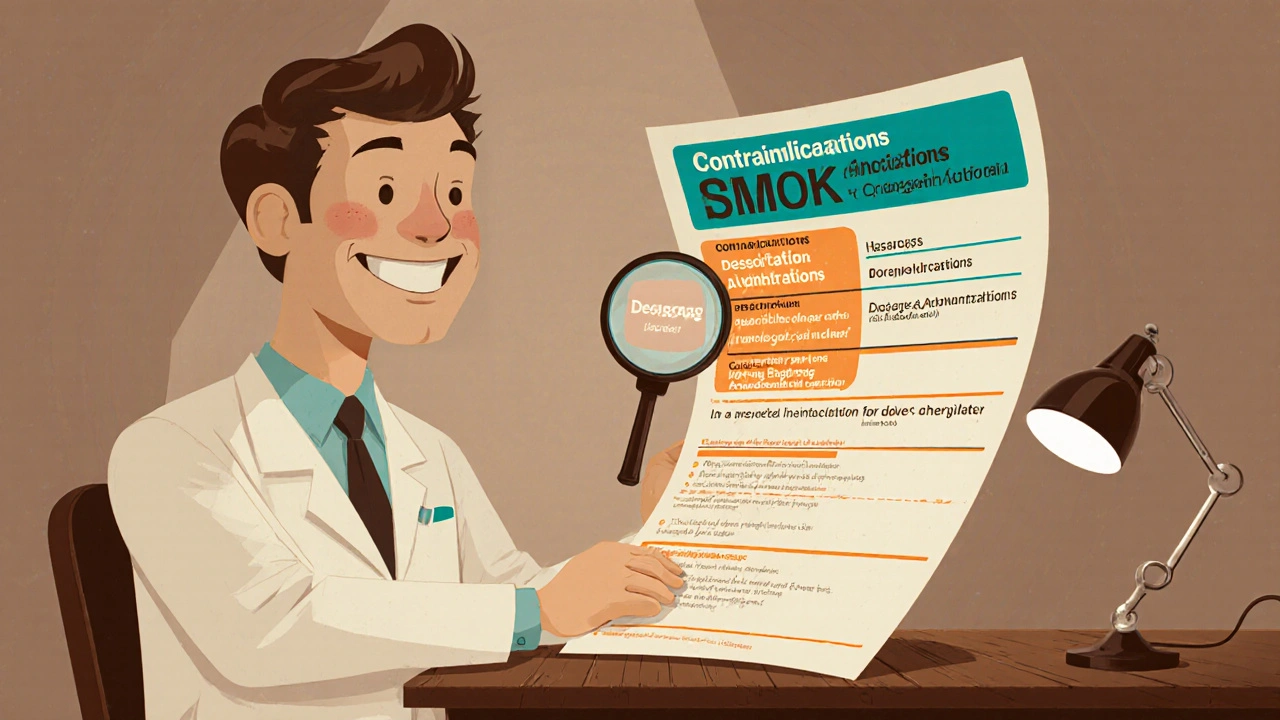

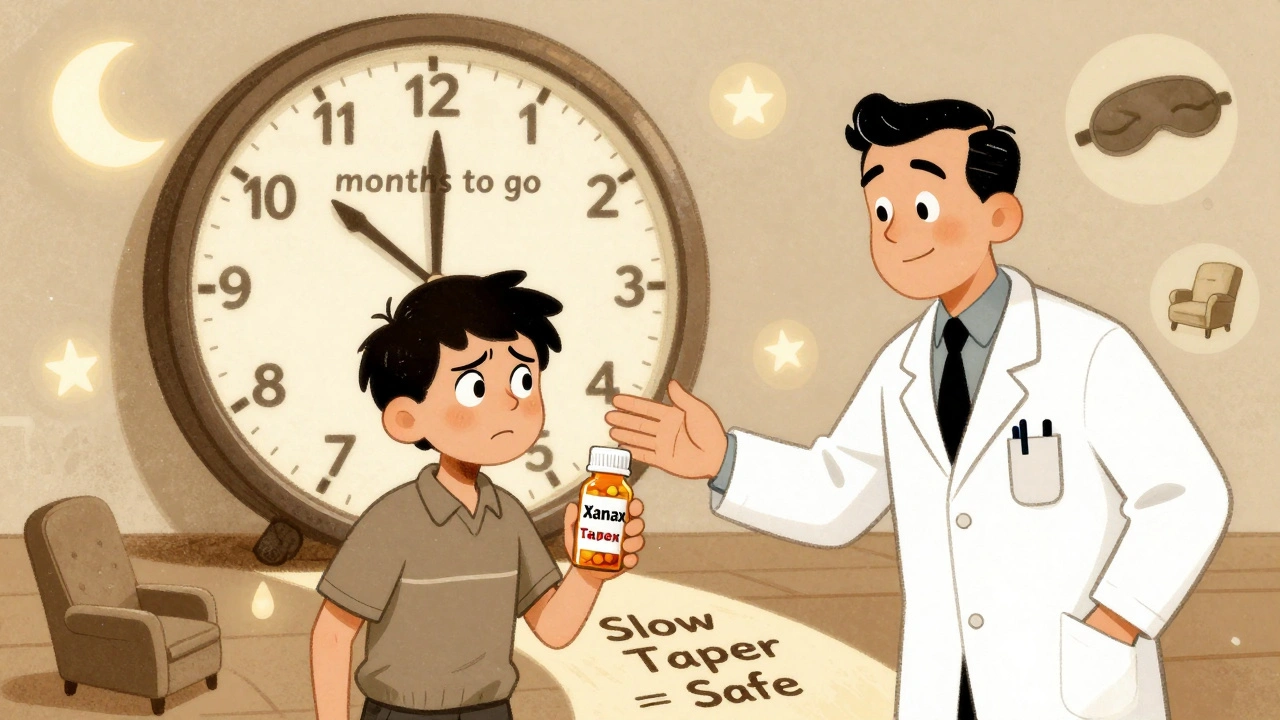

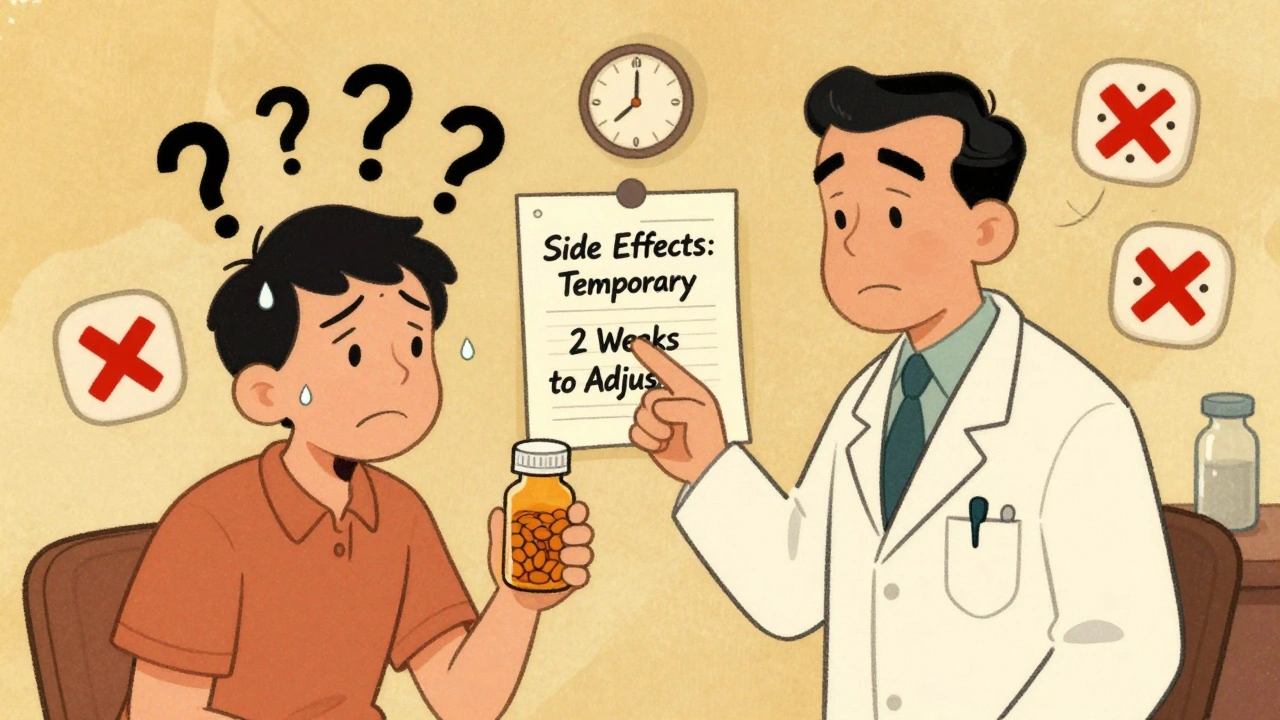
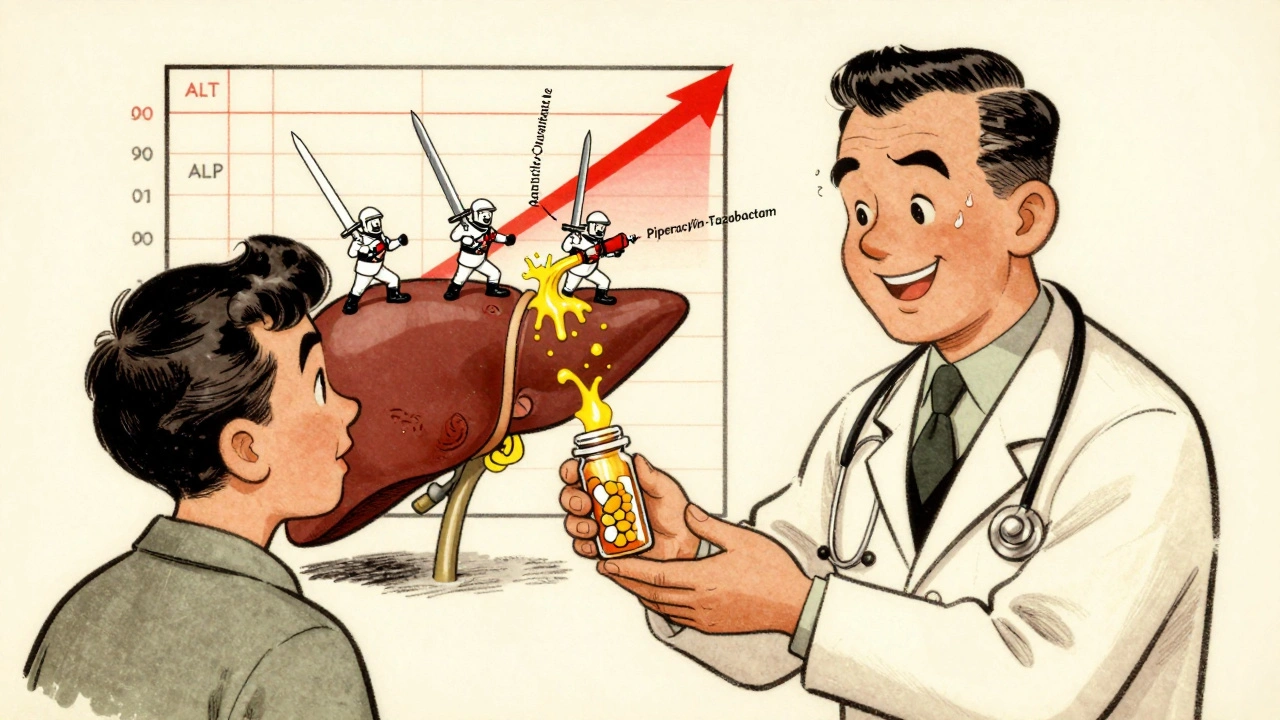
Megan Dicochea
October 25, 2025 AT 19:13Thanks for pulling together a clear rundown of the FDA label sections. The distinction between contraindications and precautions is especially useful for quick chart checks. I’ll start using the Highlights box as you suggested to catch the most critical warnings first.
ALBERT HENDERSHOT JR.
November 4, 2025 AT 13:51What a comprehensive guide; it elegantly bridges the regulatory language and everyday clinical practice. By demystifying each term, you’re not only enhancing safety but also empowering clinicians to think more critically about risk‑benefit decisions 😊. The inclusion of real‑world examples, such as the Xarelto contraindication, grounds the discussion in tangible patient care.
Kala Rani
November 14, 2025 AT 09:29Honestly the whole glossary feels like overkill for most prescribers. Most of us just glance at the box warnings and move on; diving deep into every section can slow down the workflow. The FDA could streamline labels instead of demanding we read paragraphs of legalese.
eko lennon
November 24, 2025 AT 05:08Stepping into the world of FDA drug labels feels like being thrust onto a stage where every word is a spotlight that can either illuminate a patient’s salvation or cast a shadow of danger.
I remember the first time I opened a label for a new oncology agent and felt my heart race as the sheer volume of sections loomed before me.
The Contraindication section, with its stark language of “must not be used,” is akin to a thunderclap that halts the entire performance.
Absolute contraindications are the drama‑free zones where no amount of clinical finesse can justify proceeding.
Relative contraindications, on the other hand, invite a delicate dance of risk‑benefit analysis, much like a tightrope walk over a canyon of uncertainty.
When you flip to the Dosage and Administration page, the step‑by‑step instructions read like a choreographed ballet, each movement timed to the second.
Missing a single beat-say, a milligram too much-can turn a therapeutic pirouette into a catastrophic fall.
The Highlights box is the opening act that captures the audience’s attention, summarizing the most critical warnings in bold, red‑stained lettering.
Boxed Warnings are the dramatic spotlights that force every clinician to pause, reflect, and perhaps rewrite the script of treatment.
Drug Interaction tables read like complex ensemble casts, each actor (enzyme, transporter) influencing the others in unpredictable ways.
The FDA’s requirement for clear, concise language is the director’s relentless demand for a flawlessly rehearsed performance.
Yet, the legalese peppered throughout the label can feel like an indecipherable sub‑text that only lawyers seem to grasp.
Nevertheless, mastering this script empowers prescribers to deliver care with confidence, knowing they’ve consulted every act and scene.
In practice, I now scan the Highlights first, then dive into the full label only when the plot thickens.
So, fellow clinicians, treat the label as your backstage pass – it grants you access to every nuance, every precaution, and ultimately, every chance to save a life.
Happy reading, and may your prescriptions always hit the right note.
Sunita Basnet
December 4, 2025 AT 00:46Striking the balance between safety and efficacy is the golden thread that weaves through every FDA label term – think pharmacodynamics, therapeutic window, and risk mitigation strategies all in one concise package. Leveraging the Highlights section turbocharges our clinical decision‑support tools and keeps the patient journey on a smooth trajectory. Let’s champion this jargon‑rich roadmap and turn label literacy into a daily habit!
Pamela Clark
December 13, 2025 AT 20:24Oh brilliant, another glossy cheat sheet for us mere mortals to pretend we understand the labyrinthine intricacies of 21 CFR. As if we didn’t already have to memorize every boxed warning for our board exams, this “glossary” just adds another layer of pretentious fluff. Can’t wait for the next edition where they translate legalese into emoji.
Diane Holding
December 23, 2025 AT 16:02Appreciate the humor – the core takeaway is still valuable: focus on the Highlights and stay alert to boxed warnings.